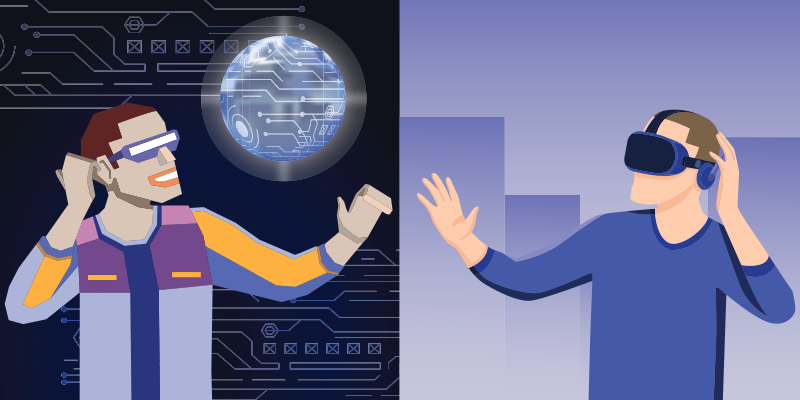Neuroscientist Jenifer Miehlbradt knelt down next to a brown-haired 6-year-old boy. She fitted a visor over his eyes and head, fastened a sensor to his back, and with the push of a button, launched him into a virtual sky.
Strapped into his VR gear, the boy was no longer just a boy but an eagle soaring through a 3-D azure, using his torso to steer. The boy had been instructed to capture gold coins decorating a path that stretched out before him like a snake. But something was amiss—he couldn’t calibrate his flight. He kept veering off track, leaving the golden coins out of reach.
The virtual flight game was part of a study of 80 children between the ages of 6 and 10, conducted over the course of several years at the Swiss Federal Institute of Technology at Lausanne, in collaboration with the Italian Institute of Technology at Genova. The results revealed something unexpected: Children under 10 can’t coordinate their movements in the virtual world as they would in real life.
Published in Nature’s Scientific Reports in September, the findings suggest that immersive virtual reality can, at least over the short-term, disrupt the normal process of sensory integration for kids, whereby vision, balance, orientation and touch combine into an organized signal in the brain that directs posture and movement.1
Perhaps the visual stimulus overwhelms the brains of kids, like a symphony in which the horn drowns out the other instruments.
“When you enter the virtual world, the rules of sensory experience change, which could impact kids’ development,” said Miehlbradt. “Maybe it’s totally safe, or maybe it’s not. Either way we need to know a lot more about what happens to them when they slip into avatar.”
The question of what happens to kids when they enter the virtual world has suddenly become a lot more pressing. Late last year Meta, formerly known as Facebook, announced it would be launching a new metaverse, a social virtual reality platform where users can inhabit fully imagined 3-D digital worlds via embodied avatars. Meta’s new metaverse could vastly increase kids’ exposure to immersive VR.
Already, VR gaming is huge among kids. Interest surged during the pandemic, when getting together with friends in-person became close to impossible. The most popular immersive VR gaming environment for children is called Roblox, which has over 48 million daily active players. In 2020, Roblox told The Verge that over half of American kids and teens under the age of 16 use the platform.2 They skateboard through virtual skateboarding parks, adopt virtual pets, and just hang out.
If you ask a 5-year-old who’s holding a glass of water to lean forward, you’ll end up with a puddle on the floor—she can’t lean forward and simultaneously adjust her arm to hold the glass steady. This is the case, Miehlbradt explains, because most kids under 10 have not yet mastered coordination or postural control.
Coordination and a steady posture are critical for some of the most basic activities of daily life: getting out of bed, putting on your underwear, walking to the bathroom, making sure your breakfast makes it into your mouth. But these basic skills depend on a long and elaborate process of development that begins before birth and extends into early adulthood.

A key component of this process is the maturation of multisensory integration, the combination of different cues from the environment and from the body—sight, sound, touch, motion, and balance—to map a precise estimate of one’s surroundings and one’s interactions with those surroundings, a capacity that develops throughout in childhood.1
Until about the age of 7, kids tend to move their upper bodies as a single unit, with rigid links between the head, torso, and arms. After age 7, they begin to learn to control their joints independently, but resort to a rigid posture during challenging tasks, such as walking on a balance beam.
This is not what happened in Miehlbradt’s flight test, however. When the kids tried to manage the challenging task of steering the eagle’s flight, they moved their heads and torsos out of sync, exaggerating their head movements. In other words, though they had been instructed to steer with their torsos, they seemed to be trying to steer with their heads. Miehlbradt speculates that this disjointed approach may be related to the novelty of the visual stimulus in the virtual world—differences in depth and perspective and unfamiliar environments.
Perhaps the visual stimulus overwhelms the immature brains and bodies of kids under 10, she suggests, causing them to favor visual inputs relative to others, such as balance and orientation, sort of like listening to a symphony in which the horn drowns out all of the other instruments.
“When you enter the virtual world, the rules of sensory experience change.”
Although immersive VR has been around for decades, what lasting effects it may have on neurological and sensorimotor development still remains largely a mystery. Scientists and regulators have3 cautioned for years4 that VR could pose risks to kids’ vision and balance, but so far researchers have done few long-term studies and there is no final consensus on this point.
Some studies have shown VR users under 13 fare worse on measures of balance and visual depth perception after immersive VR experiences, whereas other studies report little harm beyond eye discomfort and some trouble with motion sickness.5 Elsewhere, VR has been demonstrated to actually improve balance in children with cerebral palsy.6
The short-term impacts of VR on kids’ behavior are somewhat better understood. Over the past decade, Jakki Bailey, a global leader in VR research with children, has tested VR systems on hundreds of preschoolers (age 3 to 6).7 So far, her findings suggest that, even in small doses, VR leaves a more powerful impression on kids than similar experiences with TV or other media, and that kids have a harder time than adults distinguishing the virtual from the real world. This is called “presence” in research terms, and it’s why even most adults have trouble stepping off a gangplank in immersive VR despite knowing that in reality, an office carpet lies just below.
We still know so little about how the long-term impacts of VR on the neurological and behavioral development of kids in part because of the particular challenges that come with collecting data on minors, says Andrea Stevenson Won, an assistant professor at Cornell University and the director of the Virtual Embodiment Lab.
Ethics boards are unlikely to approve studies that require children to use VR repeatedly over long periods of time, given the potential risks. Parental consent poses additional hurdles. Existing studies on children and VR also primarily have a clinical bent and have tended to focus on children with atypical as opposed to normal development.
Bailey hopes the field will generate “larger frameworks and ideas” about the ideal applications of VR, for instance, at what ages and what settings VR works best. We might see some findings come first from classrooms, she says, where teachers have been piloting VR to visualize fractions and embark on “reverse field trips” into the past, since the early 2000s.
“People often ask, if I use VR, will it ruin me?”
Mielhbradt hopes to follow up on her flight test research with a new project that examines the effects of adding haptic feedback (vibrations) to kids’ VR experiences, to see whether that counteracts the brain’s overweighting of visual feedback. If the original finding holds up, the next step would be to measure whether VR disrupts the development of sensory integration or coordination over the long-term.
One caveat is that the weight of the headsets on smaller children’s bodies could have influenced the results of her original study. But Miehlbradt and her colleagues believe that it is more likely that this weight would have helped kids to correct their coordination, rather than disturb it. Using newer lightweight headsets could resolve this problem in future research.
In the meantime, the therapeutic applications of virtual reality are growing and these same lighter headset designs will greatly expand VR’s potential for pediatric research and treatment. The possibilities span a wide array of conditions, including traumatic brain injuries,8 autism,9 ADHD,10 cerebral palsy,11 lazy eye,12 pain,13 panic disorders,14 and anxiety.15
In October 2021, Luminopia became the first virtual reality therapy for kids to receive FDA approval. It is approved as a prescription treatment for lazy eye for kids between 4 and 7 years of age. But Luminopia is a non-immersive application of VR; kids are not operating virtual avatars to move through space, which means it has less potential to interfere with their sensorimotor experience.
“People often ask, if I use VR, will it ruin me?” says Stevenson Won. She believes that, in small, controlled doses, it has the power to do the opposite: to make some bodies and brains better adapted to the real world. But how kids respond to VR in the setting of the lab or the clinic will likely be very different from how they respond to it in the wild west of the metaverse.
It will be up to researchers, parents, regulators, and perhaps even kids themselves to ensure that their adventures in virtual reality enhance rather than disrupt their growth into full-fledged adulthood.
Kelsey Ichikawa is a budding researcher with interests in the politics and ethics of science. She graduated from Harvard in 2020 with an A.B. in neurobiology and philosophy, and is currently based in California. You can follow her on Twitter @IchikawaKelsey
Lead image: Chaosamran_Studio / Shutterstock
References
1. Miehlbradt, J. Immersive virtual reality interferes with default head-trunk coordination strategies in young children. Nature Scientific Reports 11, 17959 (2021).
2. Lyles, T. Over half of US kids are playing Roblox, and it’s about to host Fortnight-esque virtual parties too. The Verge (2021).
3. Federal Trade Commission Consumer Alert. Virtual worlds and kids: mapping the risks. https://permanent.fdlp.gov/LPS108167/LPS108167/www.ftc.gov/bcp/edu/pubs/consumer/alerts/alt038.pdf (2009).
4. Rushton, S.K. Developing visual systems and exposure to virtual reality and stereo displays: some concerns and speculations about the demands on accommodation and vergence. Applied Ergonomics 30, 69-78 (1999).
6. Tychsen, L. Effects of immersive virtual reality headset viewing on young children: Visuomotor function, postural stability, and motion sickness. American Journal of Ophthalmology 209, 151-159 (2020).
7. Ravi, D.K. Effectiveness of virtual reality rehabilitation for children and adolescents with cerebral palsy: an updated evidence-based systematic review. Physiotherapy 103, 245-258 (2017).
8. Aubrey, J.S., Robb, M.B., Bailey, J., & Bailenson, J. Virtual Reality 101: What You Need to Know About Kids and VR. Common Sense, San Francisco, CA (2018).
9. Shen, J., Johnson, S., Chen, C., & Xiang, H. Virtual reality for pediatric traumatic brain injury rehabilitation: A systematic review. American Journal of Lifestyle Medicine 14, 6-15. (2018).
10. Dixon, D.R., et al. Evaluation of an immersive virtual reality safety training used to teach pedestrian skills to children with autism spectrum disorder. Behavior Analysis Practice 13, 631–640 (2020).
11. Shirley Shema-Shiratzky, S., et al. Virtual reality training to enhance behavior and cognitive function among children with attention-deficit/hyperactivity disorder: brief report. Developmental Neurorehabilitation 22, 431-436, (2019).
12. Warnier, N., Lambregts, S., & Van De Port, I. Effect of virtual reality therapy on balance and walking in children with cerebral palsy: A systematic review, Developmental Neurorehabilitation 23, 502-518 (2020).
13. Xiao, S. Randomized controlled trial of a dichoptic digital therapeutic for amblyopia. Opthamology 129, 77-85 (2022).
14. Stevenson Won, A., et al. Two virtual reality pilot studies for the treatment of pediatric CRPS. Pain Medicine 16, 1644-1647 (2015).
15. Shin, B., et al. Effectiveness of self-guided virtual reality–based cognitive behavioral therapy for panic disorder: randomized controlled trial. JMIR Mental Health 8, e30590 (2021).
16. Arane, K., Behboudi, A., & Goldman, R.D. Virtual reality for pain and anxiety management in children. Canadian Family Physician 63, 932-934 (2017).

























